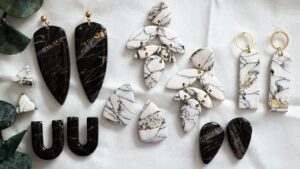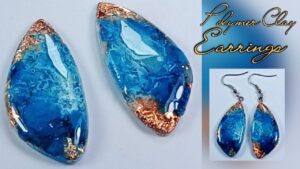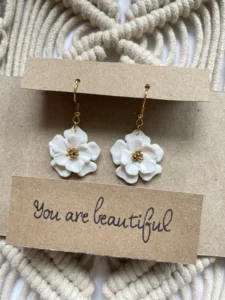Polymer clay is a versatile and affordable material that allows artists and crafters to create stunning handmade jewelry. Whether you’re a beginner or an experienced jewelry maker, polymer clay offers endless possibilities for designing unique earrings, pendants, bracelets, and rings. This article explores various handmade jewelry projects using polymer clay, essential tools, techniques, and tips to help you get started.
Handmade Jewelry Projects Using Polymer Clay

1. Why Choose Polymer Clay for Jewelry Making?
Polymer clay is a popular choice for handmade jewelry because:
- Easy to Work With – Soft and moldable, making it perfect for intricate designs.
- Durable – Once baked, polymer clay hardens into a sturdy material suitable for everyday wear.
- Lightweight – Comfortable for earrings, necklaces, and statement jewelry.
- Endless Colors & Effects – Available in multiple colors and can be blended, textured, or layered for stunning effects.
- Affordable & Accessible – Requires minimal tools and is widely available at craft stores.
- Non-Toxic & Safe – Ideal for home use, as it does not require a kiln or specialized equipment.
2. Essential Tools and Materials
Before starting your polymer clay jewelry projects, gather the following tools and materials:
- Polymer Clay – Brands like Sculpey, Fimo, and Premo offer various colors and finishes.
- Clay Blades – For precise cutting and shaping.
- Rolling Pin or Acrylic Roller – To flatten clay evenly.
- Clay Cutters & Shape Templates – To create uniform designs.
- Needles or Toothpicks – For making holes and adding texture.
- Jewelry Findings – Earring posts, jump rings, necklace chains, and bracelet clasps.
- Baking Surface – A ceramic tile or parchment paper for even baking.
- Varnish or Glaze – To add a glossy or matte finish.
- Oven – Polymer clay cures at low temperatures (typically 275°F/130°C).
- Paints & Pigments – For adding extra details or special effects like metallic finishes.
- Sanding & Buffing Tools – To refine edges and enhance the final look.
3. Popular Polymer Clay Jewelry Projects
a. Statement Earrings
Polymer clay earrings are trendy, lightweight, and easy to customize. Popular designs include:
- Abstract & Geometric Shapes – Cut circles, triangles, and arches for modern styles.
- Marbled Effects – Blend multiple clay colors to create a marbled look.
- Textured Earrings – Use stamps or lace fabric to imprint unique patterns.
- Gold Leaf & Metallic Accents – Add a touch of luxury by incorporating gold or silver leaf.
- Layered & Multi-Piece Designs – Connect multiple clay elements with jump rings for movement.
- Floral & Nature-Inspired Motifs – Use small clay sculpting tools to shape flowers and leaves.
b. Handmade Pendants
Design eye-catching polymer clay pendants for necklaces using these techniques:
- Mokume Gane Technique – Layering and slicing clay for a woodgrain or gemstone effect.
- Caning Technique – Creating intricate patterns that reveal stunning cross-sections.
- Stamped & Carved Designs – Press stamps or carve details for a personalized look.
- Glow-in-the-Dark & Translucent Clays – Experiment with different materials for unique effects.
- Encasing Beads & Crystals – Embed small gemstones or beads for an elegant finish.
c. Bracelets & Bangles
Polymer clay bracelets can be made in:
- Slab Bracelets – Cut clay into wide bands and bake into sturdy cuff-style bracelets.
- Beaded Bracelets – Roll polymer clay into beads, bake, and string onto elastic or wire.
- Textured Bangles – Use texture rollers or press objects like leaves for natural patterns.
- Adjustable Cuffs – Shape the clay around a bracelet mold before baking.
- Ombre & Gradient Designs – Blend colors for a fading effect across the bracelet.
d. Rings & Miniature Charms
- Simple Clay Rings – Shape thin strips of clay and wrap them around mandrels before baking.
- Miniature Food Charms – Create tiny cupcakes, fruits, or candy charms for playful jewelry.
- Crystal & Gemstone Imitations – Mimic opals, turquoise, or amethyst using color layering.
- Stackable Rings – Make thin clay rings in different colors and stack them for a boho style.
- Engraved or Stamped Rings – Press tiny letters or symbols into the clay before baking.
4. Tips for Working with Polymer Clay
- Condition Your Clay – Knead the clay thoroughly before use to make it pliable.
- Prevent Fingerprints – Use cornstarch or gloves to keep clay smooth.
- Bake Properly – Follow the manufacturer’s instructions and avoid underbaking.
- Use a Ceramic Tile for Baking – Prevents warping and ensures even heat distribution.
- Sand & Buff – Use fine-grit sandpaper to smooth edges after baking.
- Seal for Protection – Apply a varnish or resin for added durability and shine.
- Experiment with Mixed Media – Combine polymer clay with resin, metal, or wood elements for unique designs.
5. Selling & Gifting Handmade Polymer Clay Jewelry
Handmade polymer clay jewelry makes a great gift or small business idea. Consider these steps:
- Brand Your Work – Create a unique style and packaging for your jewelry.
- Sell on Platforms – Etsy, Instagram, and craft fairs are great places to showcase your work.
- Price Your Jewelry Fairly – Consider material costs, labor, and market trends.
- Offer Custom Designs – Personalization adds value and attracts customers.
- Create Collections – Launch seasonal or themed collections to attract repeat buyers.
- Use Professional Photography – Well-lit and clear product images increase sales.
- Engage with Customers – Build an online presence through social media and tutorials.
6. Caring for Polymer Clay Jewelry
To ensure longevity, follow these care tips:
- Avoid Prolonged Water Exposure – While durable, polymer clay is not waterproof.
- Store Properly – Keep in a cool, dry place away from direct sunlight.
- Clean Gently – Wipe with a damp cloth; avoid harsh chemicals.
- Avoid Dropping – Though sturdy, some delicate designs can break upon impact.
Polymer clay is a fantastic medium for crafting one-of-a-kind jewelry pieces. Whether making statement earrings, intricate pendants, or custom charms, the possibilities are endless. With the right tools, techniques, and creativity, anyone can enjoy making beautiful handmade jewelry from polymer clay. The affordability, accessibility, and versatility of this material make it ideal for beginners and professionals alike. Whether for personal use, gifts, or starting a small jewelry business, polymer clay opens up endless creative opportunities.


